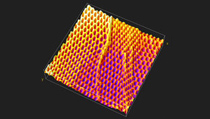In nature, cells and tissues are collected and organized independently within a system of protein fibers that will ultimately determine their structure and function, such as the elasticity of the skin and the contractility of the heart tissue. These natural design principles have now been successfully replicated in a bioengineering laboratory at Harvard University.

"Until now, it has been very problematic to mimic this extracellular substrate using man-made materials," said Adam W. Feinberg, a research fellow at Harvard University. "However, we believed that if cells are able to create such a substrate on the surface of their membranes, maybe we can create it on a surface as well. We were excited to see that we succeeded." The researcher is the lead author of an article describing the research that was published in the scientific journal Nano Letters.
In the field of tissue engineering, their technology, known as "protein nanofabrics", is a significant step forward. Current methods for tissue regeneration are often based on the use of artificial polymers for the preparation of scaffold structures (templates on which the cells gather and grow). However, this approach may lead to harmful side effects during the degradation of the polymer. In contrast, nanofibers are composed of the same proteins that make up the normal tissues in the body, and therefore the body is able to break them down from the moment they are no longer required without the development of harmful effects. Preliminary findings showed the development of heart muscle fibers, which could lead to the development of innovative methods for repairing and regenerating all types of heart cells.
"Using these nanofibers, we are able to control the amount of fibers, their directionality, and their composition, an ability that allows us to create engineering scaffolds of new tissues that will direct regeneration," said the researcher. "In addition, it allows us to use the nanometric properties of these proteins in new ways beyond medical applications. There is a wide range of applications for this method that utilizes designed artificial proteins."
High quality textiles are the second main application of this technology. By changing the type of protein used to build the substrate, researchers can change the amount of fibers, their arrangement in space and other properties to prepare fibers with extraordinary properties. Today, a rubber band can be stretched up to 600-500 percent of its original length, but such future fabrics will be able to do so at rates of up to 1500 percent stretching. Future applications of such fabrics extend from clothing adapted to the wearer, to bandages that accelerate healing to industrial products.

One response
In Hebrew it is called "Talai"